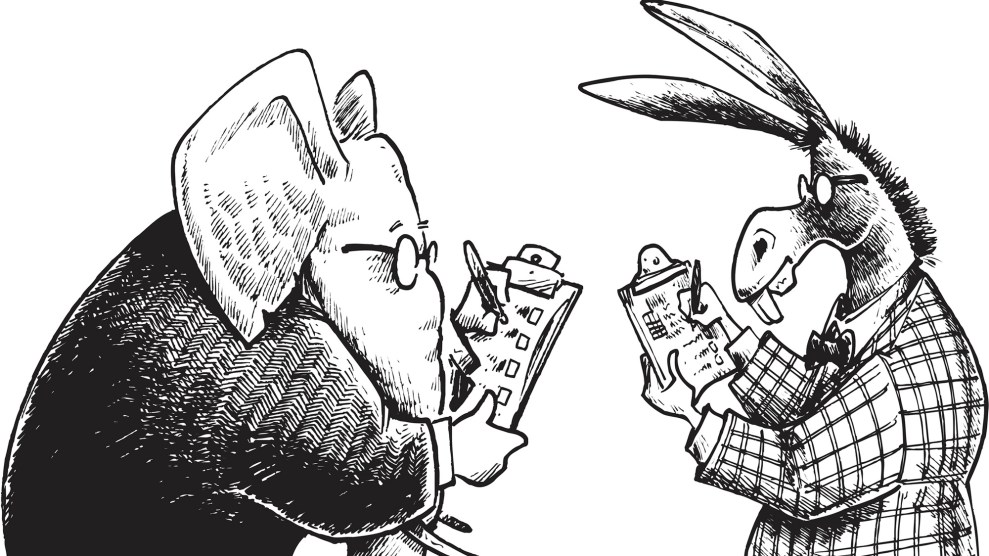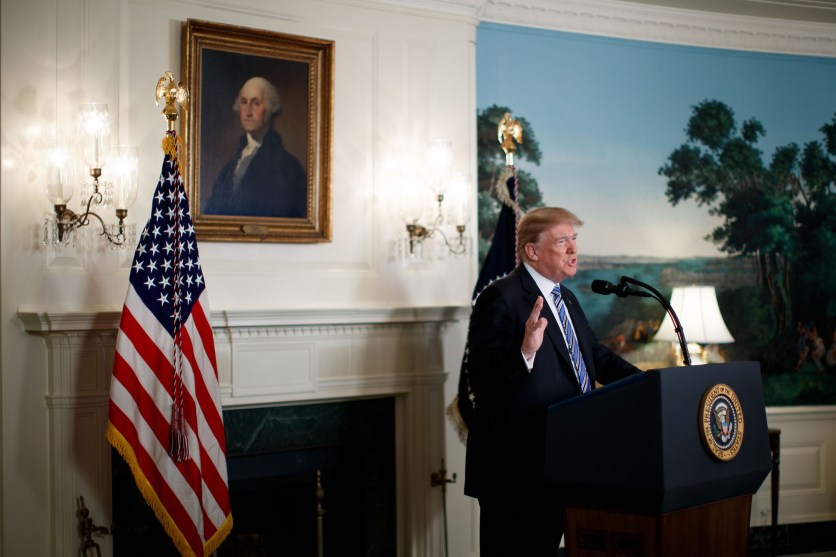
Keith Bishop/Getty Images
This article first appeared on TomDispatch.com.
The immigration debate seems to have gone crazy.
President Obama’s widely popular Deferred Action for Childhood Arrivals program, which offered some 750,000 young immigrants brought to the United States as children a temporary reprieve from deportation, is ending—except it isn’t…except it is. President Trump claims to support DACA but ordered its halt, while both Republicans and Democrats insist that they want to preserve it and blame each other for its impending demise. (Meanwhile, the Supreme Court recently stepped in to allow DACA recipients to renew their status, at least for now.)
On a single day in mid-February, the Senate rejected no less than four immigration bills. These ranged from a narrow proposal to punish sanctuary cities that placed limits on local police collaboration with Immigration and Customs Enforcement (ICE) officials to major overhauls of the 1965 Immigration and Nationality Act, which established the current system of immigration quotas (with preferences for “family reunification.”)
And add in one more thing: Virtually everyone in the political sphere is now tailoring his or her pronouncements and votes to political opportunism rather than the real issues at hand.
Politicians and commentators who once denounced “illegal immigration,” insisting that people “do it the right way,” are now advocating stripping legal status from many who possess it and drastically cutting even legalized immigration. These days, the hearts of conservative Republicans, otherwise promoting programs for plutocrats, are bleeding for low-wage workers whose livelihoods, they claim (quite incorrectly), are being undermined by competition from immigrants.
Meanwhile, Chicago Democrat Luis Gutiérrez—a rare, reliably pro-immigrant voice in Congress—recently swore that, when it came to Trump’s much-touted wall on the Mexican border, he was ready to “take a bucket, take bricks, and start building it myself…We will dirty our hands in order for the Dreamers to have a clean future in America.”
While in Gutiérrez’s neck of the woods, favoring Dreamers may seem politically expedient, giving in to Trump’s wall would result in far more than just dirty hands, buckets, and bricks—and the congressman knows that quite well. The significant fortifications already in place on the border have already contributed to the deaths of thousands of migrants, to the increasing militarization of the region, to a dramatic rise of paramilitary drug- and human-smuggling gangs, and to a rise in violent lawlessness on both sides. Add to that a 2,000-mile concrete wall or some combination of walls, fences, bolstered border patrols, and the latest in technology, and you’re not just talking about some benign waste of money in return for hanging onto the DACA kids.
In the swirl of all this, the demands of immigrant rights organizations for a “clean Dream Act” that would genuinely protect DACA recipients without giving in to Trump’s anti-immigration demands have come to seem increasingly unrealistic. No matter that they hold the only morally coherent position in town—and a broadly popular one nationally—DACA’s congressional backers seem to have already conceded defeat.
It won’t surprise you, I’m sure, to learn that Donald Trump portrays the world in a strikingly black-and-white way when it comes to immigration (and so much else). He emphasizes the violent criminal nature of immigrants and the undocumented, repeatedly highlighting and falsely generalizing from relatively rare cases in which one of them committed a violent crime, such as the killing of Kate Steinle in San Francisco. His sweeping references to “foreign bad guys” and “shithole” countries suggest that he applies the same set of judgments to the international arena.
Under Trump’s auspices, ICE, the agency in charge of applying the law to immigrants, has taken the concept of criminality to new heights to justify expanded priorities for deportation. An actual criminal conviction is no longer necessary; an individual with “pending criminal charges” or simply a “known gang member” is also now an ICE “priority.” A fear-inspiring accusation, or even a rumor, is all that’s needed to deem an immigrant a criminal.
And such attitudes are making their way deeper into this society. I’ve seen it at Salem State University, where I teach. In a recent memo explaining why he opposes giving the school sanctuary-campus status, the campous’ chief of police insisted his force must remain authorized to report students to ICE when there are cases of “bad actors…street gang participation…drug trafficking…even absent a warrant or other judicial order.” In other words, due process be damned, the police—any police—can determine guilt as they wish.
This tendency toward such a Trumpian Manichaean worldview, now being used to justify the growth of what can only be called an incipient police state, is so strong that it’s even infiltrated the thinking of some of the president’s immigration opponents. Take “chain migration,” an obscure concept previously used mainly by sociologists and historians to describe 19th and 20th century global migration patterns: Trump recently made it his epithet du jour.
Because the president spoke of “chain migration” in such a derogatory way, anti-Trump liberals immediately assumed the phrase was inherently insulting. MSNBC correspondent Joy Reid charged that “the president is saying that the only bill he will approve of must end what they call ‘chain migration’ which is actually a term we in the media should just not use! Because quite frankly it’s not a real thing, it’s a made up term…[and] so offensive! It’s shocking to me that we’re just adopting it wholesale because Stephen Miller wants to call it that…[The term should be] family migration.”
Similarly, New York Senator Kirsten Gillibrand claimed that “when someone uses the phrase chain migration…it is intentional in trying to demonize families, literally trying to demonize families, and make it a racist slur.” House Minority Leader Nancy Pelosi agreed: “Look what they’re doing with family unification, making up a fake name, chain. Chain, they like the word ‘chain.’ That sends tremors through people.”
But chain migration is not the same as family reunification. Chain migration is a term used by academics to explain how people tended to migrate from their home communities using pre-existing networks. Examples would include the great migration of African Americans from the rural South to the urban North and West, the migrations of rural Appalachians to Midwestern industrial cities, waves of European migration to the United States at the turn of the last century, as well as contemporary migration from Latin America and Asia.
A single individual or a small group, possibly recruited through a state-sponsored system or by an employer, or simply knowing of employment opportunities in a particular area, sometimes making use of a new rail line or steamship or air route, would venture forth, opening up new horizons. Once in a new region or land, such immigrants directly or indirectly recruited friends, acquaintances, and family members. Soon enough, there were growing links—hence that “chain” —between the original rural or urban communities where such people lived and distant cities. Financial remittances began to flow back; return migration (or simply visits to the old homeland) took place; letters about the new world arrived; and sometimes new technologies solidified ongoing ties, impelling yet more streams of migrants. That’s the chain in chain migration and, despite what the president and his supporters say, there’s nothing offensive about it.
Family reunification, on the other hand, was a specific part of this country’s 1965 Immigration and Nationality Act, which imposed quotas globally. These were then distributed through a priority system that privileged the close relatives of immigrants who had already become permanent residents or US citizens. Family reunification opened paths for those who had family members in the United States (though in countries where the urge to migrate was high, the waiting list could be decades long). In the process, however, it made legal migration virtually impossible for those without such ties. There was no “line” for them to wait in. Like DACA and Temporary Protected Status (TPS), the two programs President Trump is now working so assiduously to dismantle, family reunification has been beneficial to those in a position to take advantage of it, even if it excluded far more people than it helped.
Why does this matter? As a start, at a moment when political posturing and “fake news” are becoming the norm, it’s important that the immigrant rights movement remain accurate and on solid ground in its arguments. (Indeed, the anti-immigrant right has been quick to gloat over Democrats condemning a term they had been perfectly happy to use in the past.) In addition, it’s crucial not to be swept away by Trump’s Manichaean view of the world when it comes to immigration. Legally, family reunification was never an open-arms policy. It was always a key component in a system of quotas meant to limit, control, and police migration, often in stringent ways. It was part of a system built to exclude at least as much as include. There may be good reasons to defend the family reunification provisions of the 1965 Act, just as there are good reasons to defend DACA—but that does not mean a deeply problematic status quo should be glorified.
Those very quotas and family-reunification policies served to “illegalize” most Mexican migration to the United States. That, in turn, created the basis not just for militarizing the police and the border, but for what anthropologist Leo Chávez has called the “Latino threat narrative”—the notion that the United States somehow faces an existential threat from Mexican and other Latino immigrants.
President Trump has drawn on a long legacy here, even if in a particularly invidious fashion. The narrative evolved over time in ways that sought to downplay its explicitly racial nature. Popular commentators railed against “illegal” immigrants, while lauding those who “do it the right way.” The threat narrative, for instance, lurked at the very heart of the immigration policies of the Obama administration. President Obama regularly hailed exceptional Latino and other immigrants, even as the criminalization, mass incarceration, and deportation of so many were, if anything, being ramped up. Criminalization provided a “color-blind” cover as the president separated undocumented immigrants into two distinct groups: “felons” and “families.” In those years, so many commentators postured on the side of those they defined as the deserving exceptions while adding further fuel to the threat narrative.
Trump has held onto a version of this ostensibly colorblind and exceptionalist narrative while loudly proclaiming himself “the least racist person,” and praising DACA recipients as “good, educated, and accomplished young people.” But his Trump’s anti-immigrant extremism has gone well beyond Obama’s programs. In his attack on legal immigration, chain migration, and legal statuses like DACA and TPS, race has reared its head explicitly.
Unless they were to come from “countries like Norway” or have some special “merit,” Trump seems to believe that immigrants should essentially all be illegalized, prohibited, or expelled. Some of his earliest policy moves, like his attacks on refugees and his travel ban, were aimed precisely at those who would otherwise fall into a legal category, those who had “followed the rules,” “waited in line,” “registered with the government,” or “paid taxes”—including refugees, DACA kids, and TPS recipients—people already in the system and approved for entry or residence.
As ICE spokespeople remind us when they are asked to comment on particularly egregious examples of the arbitrary detention and deportation of long-term residents, President Trump has rescinded the Obama-era “priority enforcement” program that emphasized the apprehension and deportation of people with criminal records and recent border-crossers. Now, “no category of removable aliens [is] exempt from enforcement.” While President Trump has continued to verbally support the Dreamers, his main goal in doing so has clearly been to use them as a bargaining chip in obtaining his dramatically restrictionist priorities from a reluctant Congress.
The US Customs and Immigration Service made the new restrictionist turn official in late February when it revised its mission statement to delete this singular line: “USCIS secures America’s promise as a nation of immigrants.” No longer. Instead, we are now told, the agency “administers the nation’s lawful immigration system, safeguarding its integrity and promise…while protecting Americans, securing the homeland, and honoring our values.”
Many immigrant rights organizations have fought hard against the criminalization narrative that distinguishes the Dreamers from other categories of immigrants. Mainstream and Democrat-affiliated organizations have, however, generally pulled the other way, emphasizing the “innocence” of those young people who were brought here “through no fault of their own.”
Dreamers, TPS recipients, refugees, and even those granted priority under the family reunification policy have all operated as exceptions to what has long been a far broader restrictionist immigration agenda. Trump has now taken that agenda in remarkably extreme directions. So fighting to protect such exceptional categories makes sense, given the millions of people who have benefited from them—but no one should imagine that America’s policies have ever been generous or open.
Regarding refugees, for example, the State Department website still suggests that “the United States is proud of its history of welcoming immigrants and refugees…The US refugee resettlement program reflects the United States’ highest values and aspirations to compassion, generosity, and leadership.”
Even before Trump entered the Oval Office, this wasn’t actually true: The resettlement program has always been both small and highly politicized. For example, out of approximately seven million Syrian refugees who fled the complex set of conflicts in their country since 2011—conflicts that would not have unfolded as they did without the American invasion of Iraq—the United States has accepted only 21,000. And the fight to preserve even such small numbers looks like a losing rearguard battle.
Given that a truly just reform of our immigration system is inconceivable at the moment, it makes sense that those concerned with immigrant rights concentrate on areas where egregious need or popular sympathy have made stopgap measures realistic. The problem is that, over the years, this approach has tended to separate out particular groups of immigrants from the larger narrative and so failed to challenge the animus toward those immigrants consigned to the depths of the economic system and systematically denied the right of belonging.
In a sense, Trump is correct: There really isn’t a way to draw a hard and fast line between legal and illegal immigration, or between felons and families. Many immigrants live in mixed-status households, including those whose presence has been authorized in different ways or not authorized at all. And most of the felons, often convicted of recently criminalized, immigration-related or other minor violations, have families, too.
Trump and his followers, of course, want just about all immigrants to be criminalized and excluded or deported because, in one way or another, they consider them dangers to the rest of us. While political realism demands that battles be fought for the rights of particular groups of immigrants, it’s no less important to challenge the looming narrative of immigrant criminalization and to refuse to assume that the larger war has already been lost. In the end, isn’t it time to challenge the notion that people in general, and immigrants in particular, can be easily divided into deserving good guys and undeserving bad guys?
Aviva Chomsky is a professor of history and coordinator of Latin American studies at Salem State University in Massachusetts. Her most recent book is Undocumented: How Immigration Became Illegal.













